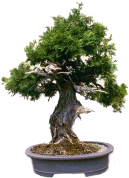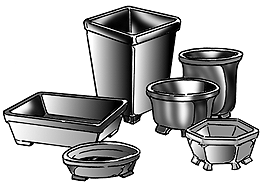Art of Bonsai
Bonsai is an art form that stems from ancient, oriental
culture, originating in China and developed by the Japanese. In the 13th
century, the Japanese collected and potted wild trees that had been dwarfed by
nature. These naturally formed miniatures were some of the first bonsai.
When demand for the small trees outgrew the supply, Japanese
gardeners began to train bonsai from native trees. They shaped the trees to give
them the illusion of age. The art of bonsai, as developed in America, is much
freer in concept and style than Japanese bonsai.
Not all plants are equally effective as bonsai. To produce a
realistic illusion of a mature tree, all parts of the ideal bonsai -- trunk,
branches, twigs, leaves, flowers, fruits, buds, roots -- should be in perfect
scale with the size of the tree. Plants used for bonsai should have small leaves
or leaves that become small under bonsai culture. Plants with overly large
leaves, such as the avocado, will look out of proportion if chosen for bonsai.
Sycamores also develop leaves that are too large. Certain species of both maple
and oak trees usually respond well to bonsai culture and develop leaves that are
in proportion. Among the plants with small leaves and needles appropriate for
bonsai are spruce, pine, zelkova, and pomegranate.
Plants chosen for bonsai should have attractive bark, and the
trunk must give the illusion of maturity. The trunk should have girth, but must
remain in proportion to the entire tree and should taper gradually toward the
top of the tree. Sometimes, one or two of the main branches must be shortened to
emphasize the vertical line of the trunk and give the trunk a balanced
appearance.
To give the appearance of age, the upper one-third of the root
structure of a mature bonsai is often exposed. Everywhere on the tree, but
mostly from the front, the branches should look balanced and appear to be
floating in space; they should not appear lopsided or top heavy. The branches
should not be opposite one another with their lines cutting horizontally across
the trunk. The branches give the bonsai dimension and establish the tree's basic
form.
A bonsai should have a harmonious arrangement of branches
without unsightly gaps. Flaws can be spotted by looking down on a bonsai. Upper
branches should not overshadow lower branches.
Bonsai can be classified into five basic styles: formal
upright, informal upright, slanting, cascade, and semicascade. These
classifications are based on the overall shape of the tree and how much the
trunk slants away from an imaginary vertical axis.
Illustrations
of bonsai styles.
Bonsai Plant Guide
Trees and shrubs are suitable for traditional bonsai.
Specialty nurseries often have a wide selection of dwarf and semidwarf varieties
of many species. Dwarf plants, however, do not always convey the same impression
as their full size counterparts because their growth habits are quite different.
Some trees and shrubs that work well as bonsai are azalea, beech, boxwood,
ginkgo, maple, oak, pine, wisteria, and zelkova.
AZALEA:
Hiryu, Rhododendron obtusum
Indica azalea, Rhododendron indicum
Kurume, Rhododendron obtusum
BEECH:
American, Fagus grandifolia
European, Fagus sylvatica
BIRCH:
White, Betula papyrifera or B. pendula
BOXWOOD:
Buxus species
FIRETHORN:
Pyracantha species
GINKGO:
Ginkgo biloba
HAWTHORN:
English, Crataegus laevigata
Washington, Crataegus phaenopyrum
HEATHER:
Scotch Heather, Calluna vulgaris
IVY:
English Ivy, Hedera helix and cultivars
MAPLE:
Amur, Acer ginnala
edge, Acer campestre
Trident, Acer buergeranum
OAK:
English, Quercus robur
Pin, Quercus palustris
Scarlet, Quercus coccinea
White, Quercus alba
PINE:
Bristlecone, Pinus aristata
Japanese white, Pinus parviflora
Japanese black, Pinus thunbergiana
Mugo, Pinus Mugo
Swiss stone, Pinus cembra
White, Pinus strobus
WISTERIA:
Japanese, Wisteria floribunda
YEW:
Taxus species and cultivars
ZELKOVA:
Japanese Zelkova, Zelkova serrata
American gardeners have taken bonsai concepts and applied them
to house plants. By combining traditional procedures for handling house plants
with bonsai concepts of design, growers have created different bonsai styles.
The following woody plants (native to the tropics and subtropics of the world)
have been grown as indoor bonsai. These plants can be obtained from either local
or specialized nurseries.
ACACIA:
Acacia baileyana
ARALIA:
Balfour, Polyscias balfouriana
Polyscias fruticosa
Geranium-leaf, Polyscias guilfoylei
CAMELLIA:
Common, Camellia japonica
Sasanqua, Camellia sasanqua
CITRUS:
Citrus species (Calamondin, kumquat, lemon, lime, orange and tangerine)
CHERRY:
Surinam, Eugenia uniflora
CYPRESS:
Arizona, Cupressus arizonica
Monterey, Cupressus macrocarpa
FIG:
Mistletoe, Ficus diversifolia
HERB:
Elfin, Cuphea hypssopifolia
HIBISCUS:
Chinese Hibiscus, Hibiscus rosa-sinensis Cooperi
HOLLY:
Miniature, Malpighia coccigera
JACARANDA:
Jacaranda acutifolia
JADE:
Crassula species
JASMINE:
Jasminum parkeri
Orange, Murraea paniculata
Confederate Star, Trachelospermum jasminoides
LAUREL:
Indian, Ficus retusa
MYRTLE:
Classic, Myrtus communis
OAK:
Cork, Quercus suber
Silk, Grevillea robusta
ORCHID TREE:
Bauhinia variegata
OLIVE:
Common, Olea euopeaea
PEPPER TREE:
California, Schinus molle
PLUM:
Natal, Carissa grandiflora
POINCIANA:
Royal, Delonix regia
POMEGRANATE:
Dwarf, Punica granatum 'Nana'
POPINAC:
White, Leucaena glauca
POWDERPUFF TREE:
Calliandra surinamensis
Creating Your Own Bonsai
Plant Selection
It is safest to begin with common plants that do well in your
area. Be sure that the plants you consider meet the requirements for good
bonsai. Some old favorites for bonsai specimens are Sargent juniper (Juniperus
chinensis 'Sargentii'), Japanese black pine (Pinus thunbergiana),
Japanese wisteria (Wisteria floribunda), Chinese wisteria (Wisteria
sinensis), Japanese flowering cherry (Prunus yedoensis), and Japanese
or sawleaf zelkova (Zelkova serrata). Nursery stock can be a very good
selection since the plant's roots have already become accustomed to cramped
conditions. Look for well-rooted specimens with good branches.
Plants for bonsai can be collected from the wild, but it is a
slow method and there are many unknown factors. It is difficult to tell the age
of a plant found in the wild and since they must be collected while dormant, it
is also difficult to be sure that the specimen is healthy. Take all the
equipment needed to keep the plant in good condition after digging. This
includes plastic bags to wrap the root ball, moss to pack around the roots, and
water to keep the specimen moist if it cannot be replanted soon after digging.
Don't forget the crowbar; roots are sometimes wrapped securely around rocks.
Be sure to have permission before digging plants on property
other than your own, and don't forget to check the endangered species list for
protected plants before you begin. It is not legal to take plants from national
parks and other conserved areas.
After the plant is selected, dug, and brought home, plant it
in a protected area in your garden. Water the plant and feed it sparingly. After
one year, it is ready to be placed in a container. A light pruning of the
branches can take place at potting time, but training should not begin for
another year.
It is possible to propagate your own bonsai. It is a slow
method, but it has the advantage of letting you shape the plant from the very
beginning. Plant seedlings in the ground outside so that the trunks will develop
rapidly. They may need to stay outdoors for two to five years. Each spring, dig
up the plant and prune its roots as you would if it were potted.
Bonsai can also be started from cuttings. Make cuttings in
late spring before the buds open. Some plants that propagate easily from
cuttings are olive, willow, cotoneaster, firethorn, azalea, and boxwood. Plants
can also be propagated by layering and grafting, but these methods are not
recommended for the beginner.
Bonsai Containers
Since roots must be pruned on plants for bonsai, the initial
containers are different from the traditional containers used later in the
plant's development. The beginning containers are called training pots. Just
about anything will do that will hold the heavy roots, but it is a good idea to
choose something similar to the sort of pot the plant will be placed in once the
roots are small and fibrous. Cascading plants should be trained in deep pots,
while tall specimens that will end up in shallow pots need to begin in fairly
shallow containers. Make sure that the drain holes in all training pots are at
least one half inch in diameter.
 Traditional bonsai
pots, available from large nurseries and some import stores, are round, oval,
square, rectangular, and hexagonal. Cascade and semicascade styles of bonsai
look good in round or rectangular pots. Place the plant in the center of the pot
with the branches sweeping over the sides. Upright trees should be placed off
center (about one third the distance from the edge) in rectangular or oval pots.
Traditional bonsai
pots, available from large nurseries and some import stores, are round, oval,
square, rectangular, and hexagonal. Cascade and semicascade styles of bonsai
look good in round or rectangular pots. Place the plant in the center of the pot
with the branches sweeping over the sides. Upright trees should be placed off
center (about one third the distance from the edge) in rectangular or oval pots.
Shaping the Bonsai
Before deciding on the shape of your bonsai, study the tree
carefully and take into account the natural form of the species. Observe the way
mature trees of the same kind grow in their natural setting to achieve an
impression of age and reality. Decide on the final shape and size of your bonsai
before starting. Make a rough sketch of what you wish to create, and use it as a
guide.
Once you have decided the general shape that you want the
bonsai to achieve, you can use the three basic operations that will accomplish
that shape. These are pruning, nipping, and wiring. A great deal of pruning is
often necessary if starting with a nursery plant. Only excess foliage and
undesirable limbs should be removed. Remember, make all cuts above a bud, a side
branch, or a main fork of the tree. Remove all buds except those on the outside
of the trunk to force growth outward and upward. Leave stubs flush with the
stems. Avoid cutting back so far that the main branches are weakened.
Do not shear bonsai as you would a hedge; the objective is to
make the plant look like a replica of a mature tree. Keep branches growing
toward open space and away from each other. Do not prune too zealously; plants
must have sufficient leaves for photosynthesis.
Heavy pruning usually only takes place once in the life of the
bonsai. Once the basic form is established, shaping is done by nipping or
pinching back. This procedure controls new growth. Nipping is done to shape the
plant and to develop luxurious foliage. Nip off tiny spurs that appear on the
trunk before they are large enough to leave scars when removed.
Roots must also be trimmed. Try to keep all fibrous roots and
maintain a balance of one branch for one root if at all possible. Remove any
roots that were damaged in digging. Leave surface roots intact. Prune the roots
with sharp, sloping cuts to avoid damaging them.
When the plant has been pruned to your satisfaction, it can
then be wired. This technique is unique to the art. Copper wire is usually used
as it is flexible. Number 8 wire is the heaviest that should be used and usually
only on the trunk. Use wire as light as number 16 for thin branches. Wire
evergreen trees only during their dormant period and deciduous trees during
their growing season.
To make the branches flexible before wiring, do not water the
plant the day before you wire it. Begin at the bottom of the tree when wiring
and shaping, and work upward. Anchor the end of the wire at the base of the tree
by pushing it into the soil. Use foam pads under the wire to protect the
branches. Keep turns around the branches or trunk about one quarter inch apart,
and spiral upward at a 45 degree angle. Do not wire too tightly. If a branch
should snap, the ends can be rejoined if not completely broken. Wind some garden
tape around the break. If a branch snaps off, prune it back at the first side
branch. Wire should not be kept on the plant longer than one year. When removing
wire, start at the end of the branch and work back carefully.
Seasonal Care
Bonsai from forest trees must live outdoors except for short
periods of time when they may be brought inside for viewing. These indoor
periods should only be for two or three hours and should not occur at all in
summer unless the interior is well ventilated.
In the summer, bonsai need cool nights, sunny days, and mist
or rain almost daily. If your climate does not offer these conditions naturally,
you must supply them. Avoid any extremes in temperature, light, rain, and wind.
Water the entire plant daily, but do not let them become water logged. Placing
bonsai on a slatted stand in the garden is a good way to keep drainage
conditions optimum. Bonsai should receive three to five hours of direct sunlight
a day, but the site should be shaded in the afternoon if possible.
Apply fertilizer only before and during active growth. A
houseplant fertilizer diluted from one quarter to one half strength will
suffice.
In the fall, bonsai must be prepared for the winter. Slow the
growth of the plants by watering less frequently and discontinuing fertilizer
application. Do not prune or cut any branches after mid-August.
Winter's low temperatures and drying winds can easily kill
bonsai. If the winter temperature drops below 28F, bonsai must be protected by a
greenhouse, pit, or coldframe. However, do not overprotect the plants; they must
be kept cool to stay dormant. Don't forget to water them while inside the
coldframe. Winter watering may be only necessary every other day. More bonsai
are killed by overwatering than by desiccation.
In the spring, start new bonsai, prune the old ones, and
continue training measures. The remaining part of the growing season is used for
the plants' adjustments to these practices.
Displaying Bonsai
Remember that simplicity is very important in Japanese
aesthetics and bonsai should be displayed in an uncluttered environment where
the details of the plant can be appreciated. This is, after all, a wonder of
nature -- trees and shrubs made miniature. Gravel beds in the garden are good
backgrounds for bonsai outdoors, and a simple stand or table before a blank wall
makes an appropriate setting indoors.
![]() Gardeners' Corner
Kids'
Garden
Sustainable Garden
Contact Us
Gardeners' Corner
Kids'
Garden
Sustainable Garden
Contact Us![]()


 Traditional bonsai
pots, available from large nurseries and some import stores, are round, oval,
square, rectangular, and hexagonal. Cascade and semicascade styles of bonsai
look good in round or rectangular pots. Place the plant in the center of the pot
with the branches sweeping over the sides. Upright trees should be placed off
center (about one third the distance from the edge) in rectangular or oval pots.
Traditional bonsai
pots, available from large nurseries and some import stores, are round, oval,
square, rectangular, and hexagonal. Cascade and semicascade styles of bonsai
look good in round or rectangular pots. Place the plant in the center of the pot
with the branches sweeping over the sides. Upright trees should be placed off
center (about one third the distance from the edge) in rectangular or oval pots.